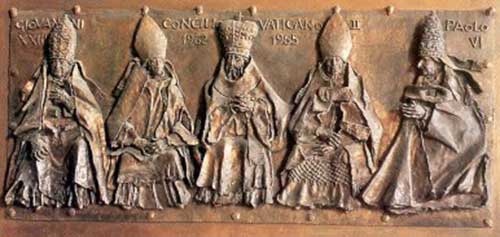This year, on 4 December, it is the 50th anniversary of the Constitution on the Sacred Liturgy (Sacrosanctum Concilium), the first document promulgated by Vatican II. I was invited to write a reflection from an Anglican perspective for Liturgy, the Roman Catholic Auckland Diocesan Liturgy Centre publication.
I am grateful that they are happy for me to post my article on my site, and encourage you to consider subscribing to the magazine.
*****
The early maxim, Lex orandi, lex credendi is important to Anglicans and Roman Catholics. The saying might be rendered as “prayer shapes belief”.
Over the last five decades both faith communities have been reversing the direction of that shaping. Belief has shaped prayer as rites and rituals have been revised and reformed.
On December 4, 1963, Pope Paul VI promulgated Sacrosanctum Concilium, the Constitution on the Sacred Liturgy, one of the constitutions of the Second Vatican Council. This year marks the 50th anniversary of that watershed event.
The sixties began with New Zealand Anglicans using authorised rites that had been little altered since the seventeenth century. But the times, as that decade would hear often, were a-changing. The interconnected movements of ecumenism, the liturgical movement, and charismatic renewal were part of driving the changes.
Celebrating the tercentenary of The Book of Common Prayer (BCP) in 1962 underlined, for Anglicans, that it belonged to a bygone age. People began to see that the best way to be faithful to the spirit of that Reformation Prayer Book was to revise its content. Within five months of that celebration New Zealand’s Anglican General Synod had voted to revise the BCP and also prepare a new lectionary.
Internationally, Anglicanism consists of 34 provinces, each governing its own worship life. New Zealand was one of the most conservative provinces liturgically, the last Anglican province to begin work on liturgical revision of the Eucharistic rites.
In the revisions, both Roman Catholics and Anglicans were drawing from a common well: the early church, the scriptures, and new liturgical scholarship. Both were living in the same context with the same challenges.
Although late to start, New Zealand Anglicans were soon leaping over the top of other provinces in new ways forward. In 1966, just as one example, these were the first to address God as “you” rather than “thou” in the officially authorised Eucharistic rite.
In those early revisions there were no agreed common revised texts. The energy of the ecumenical movement at that time, however, was soon evident. In 1969 the International Consultation on English Texts (ICET) was formed. This published Prayers We Have in Common in 1975. ICET was succeeded by The English Language Liturgical Consultation (ELLC). This produced an updated collection Praying Together. Extraordinarily, this meant we had a wonderful shared body of ecumenically agreed common texts: Lord have mercy, Glory to God in the highest, Nicene Creed, Apostles Creed, Sanctus and Benedictus, Agnus Dei, Glory be to the Father, Benedictus, Magnificat, Te Deum, the Lord’s Prayer. As time went on, the same texts were being prayed by Anglicans, Roman Catholics, and others. Musicians could produce music that was used across denominations.
The Lord’s Prayer was an exception, but in 1984 the New Zealand’s Roman Catholic bishops allowed the use of the ELLC version of the Lord’s Prayer. [It was included in the draft agreed to by the world’s English-speaking bishops, but, sadly, rejected by the Vatican in the latest Missal translation. The ELLC version of the Lord’s Prayer is still permitted for Roman Catholics outside of Mass.]
To be continued…




Hello, Bosco!
Please do not forget the Orthodox with regard to Lex orandi, lex credendi! Indeed, I would say that the WHOLE of Orthodox worship is oriented to this principle. Particularly in terms of hymnody – and all Orthodox worship (with the exception of the sermon) takes place as either hymns or chanting. In other words, the Liturgical “prayer” is always hymnic in nature. And the hymns are invariably forms of mystical prayer (mystical teachings in the form of prayer).
Here’s a link (scroll down to description of book): http://www.amazon.com/gp/product/0881410268/ref=ox_sc_act_title_1?ie=UTF8&psc=1&smid=A1BEUJJNB9US1S
Here’s another link (note description of types of hymnography along left sidebar): http://libguides.slu.edu/content.php?pid=36399&sid=317541
The amount of teaching that occurs simply from the many chants and prayers of any Orthodox Liturgy is truly astounding! Mystical Meditations, which my pastor often uses as his sermon themes.
Many blessings upon you! (And for your curious readers, Bosco has given me “special permission” to post under a pseudonym – though he knows my whole real name.)
Here’s another:
http://www.liturgica.com/html/litEOLitMusDev2.jsp
This is a particularly good example of the function of Orthodox liturgy as prayer and theological teaching in the form of chant.
Thanks, TheraP. I certainly hadn’t thought of the first sentence of my article as being exclusive, so thank you for reminding that some might read it that way. The Orthodox are clearly part of Lex orandi, lex credendi in my mind. Thanks also for the book recommendations which look great (and part of a great-looking series). Blessings.